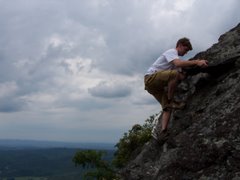
I am planning on riding the entirety of the Blue Ridge Parkway this summer on my 1990 FZR 600. I will be traveling lightly, with only what I can carry strapped to the bike and in my saddlebags. For example, I am not planning on bringing a tent or sleeping bag, instead I will take a tarp and a blanket. I will stay with friends sometimes, and sleep under a tree at others; grass for my pillow, a cool breeze as my lullaby.
My journey will begin on a Sunday in late June, when I will leave Morgantown, WV and travel to the northern end of Skyline Drive. I hope to ride the Skyline on that Sunday as well, and meet some friends near Charlottesville. Monday, my trip will begin in earnest as I start down the parkway proper. I will allow a week for the trip, though it may not take that long. My birthday, in the beginning of July, will happen on the road during the height of my travails.
This trip is not solely for the purpose of pleasure, as I plan to write a number of articles from this experience with hopes of selling them to various magazines. While on the motorcycle, my progress will (no doubt) often be rapid. However, I plan on stopping quite frequently to take pictures, videos, and journal entries with my digital voice recorder.
Although pleasure isn't the sole purpose of the trip, it has always been a dream of mine to travel this road from one end to the other. I was raised in Floyd County, VA, which is right off of the Parkway. Ever since I could drive, a desire has been growing in me to see all that the Parkway has to offer. Up until this point, I have never been able to break away. I am going to be entering graduate studies for journalism in the fall, and this summer may be my last, best chance for a long time.
I will be purchasing gear for the next few months, and will post reviews of everything that I use at the end of the trip. I welcome suggestions or donations of light, useful gear that might aid me on my journey. In addition, I encourage anyone that lives near the parkway -- and would be willing to let a weary traveler pitch a tarp in their backyard for a night -- to contact me via the comments section of this blog.
In preparation for the trip, I will be outfitting my bike with a Cortech Sport Tri-bag System, new Race-Tech Fork Springs, GenMar Handlebar Risers, and possibly a Zero Gravity Double Bubble Windscreen. I will also have a full tune-up performed, including carb syncing and cleaning, new sparkplugs, and a valve clearance adjustment.
In the next few months, I will be posting on this blog about the progression of my trip plans, and the history of the Parkway. I hope to hear some thoughts about it from folks that share my interest in this beautiful, paved ribbon of american history; especially those of you that may have already done this trip, and might have suggestions. Thanks, and be well!




































